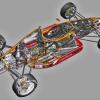Late in 1935 we made a change to the car which provided a dramatic improvement in its handling. One day I went with my father to the Nürburgring for some testing and took a good look at the car's behaviour during testing. When accelerating out of the corner, the inside rear wheel would spin furiously, trailing a stream of rubber smoke. We already had experience of this problem on some of our touring cars which had a locked differential and we had cured it by fitting a limited-slip unit. I pointed this out to my father and suggested the same cure for the Auto Union. He immediately agreed and we went back to the pits straightaway and put in a call to ZF in Stuttgart. They built up a limited-slip differential for us very quickly and the difference was quite extraordinary.
Throughout 1936 all the Mercedes drivers noticed how much better the Auto Unions accelerated out of the corners, but they didn't know why. At the end of the season Rudolf Caracciola came to visit us in Stuttgart and by then he knew the reason. Although he had lost the European Championship to Bernd Rosemeyer he was very good about it and admitted for many months he had no idea why the Auto Union was suddenly so superior!
I'm not sure I understand why a limited-slip diff would have improved the traction of a car which already had a locked differential . . .
This is a good point. However, if the use of a limited slip diff in cars of this kind was not unusual, and its advantages were known, I do wonder why it wasn't already being used on GP cars.Originally posted by Ray Bell
According to one book, the NSW 6/30 (1.6 litres) was 'very successful in competition'...
Maybe, as hillclimbs were very much in vogue in those times, this was the car spoken of and it's likely in that case that a limited slip diff would have been very helpful.


































